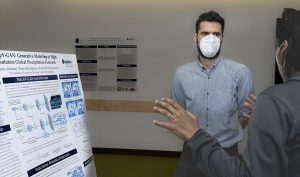
Aug. 16, 2022 — The next time an accurate weather prediction saves you from a sudden downpour, you may have James Duncan’s 2022 summer project at Lawrence Berkeley National Laboratory (Berkeley Lab) to thank.
James Duncan discusses his work at the 2022 summer student poster session. Credit: Margie Wylie, Berkeley Lab.
Duncan, a Ph.D. student in biostatistics at the University of California, Berkeley, has been working with National Energy Research Scientific Computing Center (NERSC) data architect Wahid Bhimji, NERSC Exascale Science Applications Program engineer Shashank Subramanian, and NERSC machine learning engineer Peter Harrington as part of the 2022 Berkeley Lab Computing Sciences Summer Program. Their team is developing deep generative machine-learning models for forecasting precipitation using the Perlmutter supercomputer at NERSC.
In particular, Duncan has been focusing on precipitation models, improving their resolution and incorporating an element of randomness to better mimic real-world conditions. Machine-learning models “are quite a blurry picture of precipitation compared to the ground truth,” said Duncan. “So one of the goals of this project was to try and better capture those fine-scale structures — but then also, hopefully, to predict some of the extreme states of the atmosphere like tropical cyclones and atmospheric rivers, because obviously that’s really important for disaster preparedness and safety.”
Duncan compared the improvement in resolution to predicting the behavior of the precipitation in a single large cloud, rather than a whole weather system.
The Computing Sciences Summer Program offers graduate and undergraduate students the opportunity to work with Berkeley Lab researchers on focused projects each summer.
“Working with James has been a pleasure,” said Harrington, who has served as Duncan’s mentor this summer. “We started off well since James had some experience from a previous project involving machine learning and climate science, so he already had familiarity with the dataset. This made it possible to make quick progress, and James has now developed a powerful model that is impressive in its ability to make accurate predictions on a challenging real-world task.”
The summer program has ended, but the project hasn’t: after a few more experimental runs using Perlmutter, the team will write up results for publication. Duncan also hopes to continue building on this work in his own separate research, incorporating more direct predictions over the longer term.
Duncan will also continue the path toward his Ph.D., and sees himself doing further work on weather prediction models, a relatively recent interest that has proven rewarding.
“I find the data to be super interesting; it’s really motivating. It’s all around us, you can see it. It’s interesting to know the history of weather on this planet, and to see how far back you can go. I’d definitely like to keep working in this space,” he said.
He’s also noting the benefits of a possible future in the national lab system. “I worked at Los Alamos one summer during my master’s degree and really loved it there, and I’m really enjoying working at NERSC. So you know, I think national labs are a really nice place to be.”
About NERSC and Berkeley Lab
The National Energy Research Scientific Computing Center (NERSC) is a U.S. Department of Energy Office of Science User Facility that serves as the primary high-performance computing center for scientific research sponsored by the Office of Science. Located at Lawrence Berkeley National Laboratory, the NERSC Center serves more than 7,000 scientists at national laboratories and universities researching a wide range of problems in combustion, climate modeling, fusion energy, materials science, physics, chemistry, computational biology, and other disciplines. Berkeley Lab is a DOE national laboratory located in Berkeley, California. It conducts unclassified scientific research and is managed by the University of California for the U.S. Department of Energy. Learn more about computing sciences at Berkeley Lab.
Source: Elizabeth Ball, NERSC
Source: https://www.hpcwire.com/off-the-wire/nersc-summer-student-works-toward-machine-learning-for-weather-forecasting/